TOPIC 1: CLASSIFICATION OF LIVING THINGS - BIOLOGY NOTES FORM 3
Classification of living things means to arrange animals and plants in taxonomic groups based on their observed similarities. Living things are divided into five kingdoms: animal, plant, fungi, protist and Monera
KINGDOM PLANTAE
Kingdom plantae is a kingdom in which all plants are grouped.
Plants: are multi-cellular eukaryotic organisms with ability to manufacture their own food by using energy from the sun through the process of photosynthesis.
DIVISION OF KINGDOM PLANTAE
Kingdom Plantae is made up of the following divisions:-
1. Division bryophyta e.g. Moss plants.
2. Division filicinophyta or pteridophyta. E.g. Fern plants.
3. Division coniferophyta e.g. Pines, cypress
4. Division angiospermophyta e.g. Maize, beans
GENERAL AND DISTINCTIVE FEATURES OF KINGDOM PLANTAE
i. They are multi-cellular.
ii. Their cell walls made of cellulose.
iii. They are eukaryotic organisms.
vi. They reproduce both sexually and asexually.
vii. They store food as starch.
viii. Their cells are organized into tissues, organs and organ systems.
ix. They show limited movement, for example opening and closing of flower petals.
I. DIVISION CONIFEROPHYTA (Gymnosperms)
This division is made up of the cone-bearing plants, hence the name conifers.
The members of this division are called conifers.
Conifers are plants that have needle-shaped leaves and almost all green.
They include plants such as pines, spruces, cedar, red wood, cypress and juniper.
GENERAL CHARACTERISTICS OF DIVISION CONIFEROPHYTA
The following are the general characteristics of conifers.
1. They have cones.
2. They neither have flowers nor fruits.
3. They are wind pollinated.
4. They are vascular, i.e. they have phloem and xylem tissues.
5. Their seeds are not enclosed in an ovary, but in cones.
6. They reproduce sexually by seed.
7. They do not need water for fertilization.
8. Their leaves are needle-like, linear or scale-like.
9. They have alternation of generation.
NB: Some species of conifers have male and female cones on the same individual tree while other species have plants with only male or female cones.
DISTINCTIVE FEATURES OF DIVISION CONIFEROPHYTA
1. Conifers are non-flowering but seed producing plants.
2. They have seed born in cones shaped structure rather than in fruits.
3. Their leaves are needle- shaped and have a thick cuticle for protection and to decrease water loss.
4. They are gymnosperms which means naked- seed
5. Their leaves are needle-like
6. Their seeds are enclosed in cones.
7. They have cones. The female cones contain ovules while the male cones produce microspores known as pollen.
THE STRUCTURE OF PINUS
Pinus are coniferous, evergreen resinous trees which belongs to genus Pinus
Pinus are evergreen, with needle-like leaves
Most of Pinus have thick and scaly bark, only few species have thin and flaking bark.
Pinus grow about 15 to 45 meters tall
Most of Pinus have female and male cones on the same trees
Branches of Pinus arise from the same point on the tree.
ADVANTAGES AND DISADVANTAGES OF THE DIVISION CONIFEROPHYTA
QN: Explain the advantages and disadvantages of the division coniferophyte
ADVANTAGES OF CONIFERS
1. Conifers are source of timber.
2. Some conifers are used for decoration.eg Christmas trees
3. Some conifers are source of wood pulp which is used to manufacture papers.
4. Some conifers are source of food. E.g. Pine leaves are used as food for some insects and timber, as well as cedar which many people use for their homes because of its beauty and
5. Some conifers are used as medicine. E.g. Pines and cypress are rich in vitamin; their branches cones and oils can be extracted and used as nutrient supplements.
6. Conifers are source of habitat for many birds and animals.
7. Some conifers are source of firewood and charcoal.
8. Conifers form a large arena for Biological research and Ecological studies.
9. Thick forests of conifers form green belts that modify the climate.
10. Some conifers are source of useful chemical substances such as resins.
DISADVANTAGES OF CONIFERS
1. Conifers have low reproduction rate since they rely on wind pollination and seed dispersal.
2. Conifers act as a habitat for dangerous animals such as snake etc.
3. Conifers prevent other plants from growing as they completely shade the ground below.
4. Wood products from conifers are soft and easily attacked by terminates.
(II) DIVISION ANGIOSPERMOPHYTA
This division includes all flowering plants such as mango trees, hibiscus flowers, maize, beans etc.
ANGIOSPERMS
These are flower and seed bearing vascular plants.
GENERAL FEATURES OF ANGIOSPERMS
1. They bear flowers which are reproductive structures.
2. They produce seeds enclosed in an ovary.
3. They have well developed vascular system for transporting water and dissolved substances.
4. They have alternation of generation
DISTINCTIVE FEATURES OF ANGIOSPERMS
1. They bear flowers which are reproductive structures.
2. They bear seeds enclosed in an ovary.
3. They have endosperm produced after fertilization to nourish the embryo.
4. Their haploid gametophyte is confined inside the ovary or anther of the flower.
5. They have double fertilization
Double fertilization is the process whereby one sperm fertilizes the egg cell to form the diploid zygote, while the other sperm fertilizes the central polar cell to form triploid endosperm.
CLASSES OF THE DIVISION ANGIOSPERMOPHYTA AND THEIR DISTINCTIVEFEATURES
Division Angiosperms is divided into two classes, namely:
1. Class Monocotyledon
2. Class Dicotyledonae
CLASS MONOCOTYLEDONAE
This consists of plants whose seed are made up of only one cotyledon.
i. Maize plant
ii. Grasses
iii. Palm trees
iv. Sugarcanes
DISTINCTIVE FEATURES OF CLASS MONOCOTYLEDONAE
1. Monocots have one cotyledon
2. Monocots have narrow leaves with parallel venation.
3. Monocots have fibrous root systems.
3. Floral parts are in 3, or multiple of 3.
4. Monocots have no cambium hence there is no secondary growth.
5. Monocots have scattered vascular bundles in their stems.
DIAGRAM OF MONOCOT STEM AS SEEN UNDER A LIGHT MICROSCOPE
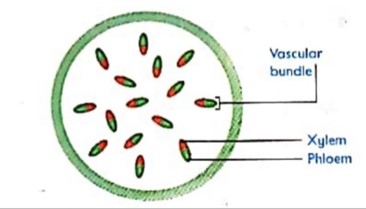
DIAGRAM OF MONOCOT ROOT AS SEEN UNDER A LIGHT MICROSCOPE
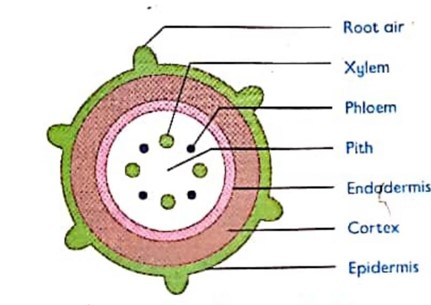
CLASS DICOTYLEDONAE
This consists of plants whose seeds are made up of two cotyledons.
Example of dicots
i. Bean plants
ii. Groundnuts
iii. Peas
iv. Sunflowers
v. Hibiscus
DISTINCTIVE FEATURES OF CLASS DICOTYLEDONAE
i. Dicots have two cotyledons
ii. Dicots have broad leaves with net-like venation.
iii. Dicots have tap root system
iv. Floral parts are in 4 or 5 or multiple of 4 or 5.
v. Dicots have vascular cambium which brings about secondary growth.
vi. Vascular bundles in dicot stem are arranged in a ring form.
DIAGRAM OF DICOT STEM AS SEEN UNDER A LIGHT MICROSCOPE
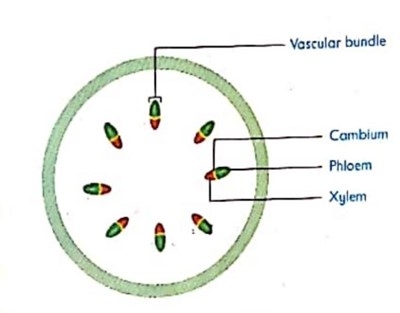
DIAGRAM OF DICOT ROOT AS SEEN UNDER A LIGHT MICROSCOPE
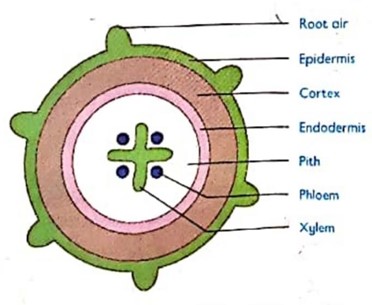
DIFFERENCES BETWEEN MONOCOTS AND DICOTS
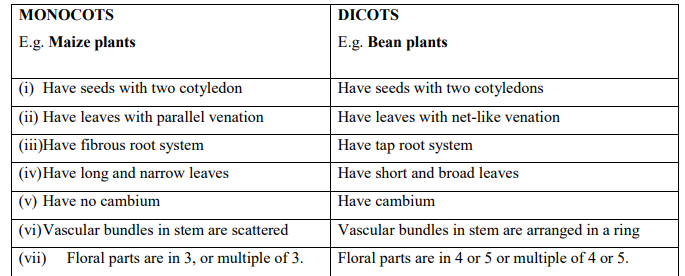
ADVANTAGES AND DISADVANTAGES OF DIVISION ANGIOSPERMOPHYTA
QN: Explain advantages and disadvantages of division angiospermophyta
ADVANTAGES OF ANGIOSPERMS
i. Angiosperms are source of food to other living organisms such as human being.
ii. Angiosperms provide different varieties of wood for furniture, paper and building materials.
iii. Some angiosperms are used to make medicine.
iv. Angiosperms are source of oxygen which is used for cellular respiration.
v. Angiosperms are source of raw materials for textile industry. E.g. cotton
vi. Angiosperms are used to modify climate.
vii. Angiosperms provide a wide range of habitats for different species of organisms.
DISADVANTAGES OF ANGIOSPERMS
i. Some angiosperms are poisonous when eaten they cause death to human and other animals. E.g. Some cassavas have cyanide acid that inhibits cellular respiration.
ii. Some angiosperms are drugs that can be abused when taken. E.g. Marijuana, cocaine, tobacco, caffeine.
iii. Some angiosperms are bad weeds, they reduce crop yields. E.g. Cuscuta kilimanjari is parasitic to coffee plantations.
SIMILARITIES OF DIVISION CONIFEROPHYTA AND DIVISION ANGIOSPERMOPHYTA
1. Both are seed producing plants
2. Both have true roots, stems and leaves
3. Both have vascular bundles
DIFFERENCES

ECONOMIC IMPORTANTCE OF KINGDOM PLANTAE
i. Plants give out oxygen which is used for cellular respiration.
ii. Plants are source of fuel to man e.g. Charcoal and firewood
iii. Plants are source of food to man and herbivorous animals,
vi. Plants beautify and decorate the environment
vii. Leguminous plants add nitrate nutrients in the soil.
viii. Some plants provide raw materials used in textile industries
ix. Some plants are source of timber.
DISADVANTAGES OF KINGDOM PLANTAE
i. Some plants are drugs that can be abused when taken. E.g. Marijuana, cocaine, tobacco, caffeine.
ii. Some plants are poisonous when eaten they cause death to human and other animals. E.g. Some cassavas have cyanide acid that inhibits cellular respiration.

